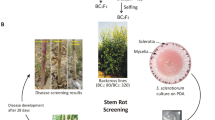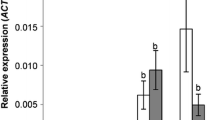Abstract
The rape stem weevil, Ceutorhynchus napi Gyll., is a serious pest of winter oilseed rape (Brassica napus L.) crops in Europe that causes stem distortion, severe disruption of stem growth, and significant yield loss. No resistance has been identified in current B. napus breeding material. Resynthesized lines of oilseed rape can be used to introduce genetic material from the parent species Brassica oleracea L. and B. rapa L. The susceptibility to C. napi of five resynthesized lines and three cultivars of oilseed rape was compared in a multi-choice field plot experiment. Morphological stem traits and stem levels of glucosinolates, carbon, and nitrogen were assessed as potential mediators of resistance. Eggs and larvae of C. napi in stems were counted weekly from the beginning of oviposition to larval maturation and stem pith degeneration in response to oviposition was assessed. Egg counts per stem were negatively dependent on stem length and positively dependent on the levels of five glucosinolates, glucobrassicanapin, glucoalyssin, glucobrassicin, neoglucobrassicin, and gluconasturtiin. The resynthesized line S30 was significantly more resistant to C. napi than the commercial cultivar Sollux, having fewer eggs and larvae. This resistance appeared to be largely antixenotic, due to the combination of a long stem and a paucity of the five key glucosinolates. We propose that resynthesized lines such as S30 should be used to introduce genes determining traits such as long stem length and glucosinolate profile into breeding programs to enhance resistance against C. napi in oilseed rape.





Similar content being viewed by others
References
Alford DV, Nilsson C, Ulber B (2003) Insect pests of oilseed rape crops. In: Alford DV (ed) Biocontrol of oilseed rape pests, 1st edn. Blackwell Science Ltd., Oxford, pp 9–42
Ali JG, Agrawal AA (2012) Specialist versus generalist insect herbivores and plant defense. Trends Plant Sci 17:293–302
Awmack CS, Leather SR (2002) Host plant quality and fecundity in herbivorous insects. Annu Rev Entomol 47:817–844
Ballanger Y (1987) Nuisibilité du charançon de la tige du colza. Phytoma 384:35–37
Barker E, Rayens W (2003) Partial least squares for discrimination. J Chemom 17:166–173
Bartlet E, Parsons D, Williams IH, Clark SJ (1994) The influence of glucosinolates and sugars on feeding by the cabbage stem flea beetle, Psylliodes chrysocephala. Entomol Exp Appl 73:77–83
Bartlet E, Blight MM, Lane P, Williams IH (1997) The responses of the cabbage seed weevil Ceutorhynchus assimilis to volatile compounds from oilseed rape in a linear track olfactometer. Entomol Exp Appl 85:257–262
Bartlet E, Kiddle G, Williams I, Wallsgrove R (1999) Wound-induced increases in the glucosinolate content of oilseed rape and their effect on subsequent herbivory by a crucifer specialist. Entomol Exp Appl 91:163–167
Baur R, Staedler E, Monde K, Takasugi M (1998) Phytoalexins from Brassica (Cruciferae) as oviposition stimulants for the cabbage root fly, Delia radicum. Chemoecology 8:163–168
Blake A, Dosdall LM, Keddie B (2010) Plant nutrients and the spatiotemporal distribution dynamics of Ceutorhynchus obstrictus (Coleoptera: Curculionidae) and its parasitoids. Environ Entomol 39:1195–1205
Bodnaryk RP (1992) Effects of wounding on glucosinolates in the cotyledons of oilseed rape and mustard. Phytochemistry 31:2671–2677
Buechi R (1988) Neue Bekaempfungsschwelle fuer den Rapsstengelruessler Ceutorhynchus napi Gyll. Mitt Schweizerischen Landwirtsch 36:110–117
Buechi R (1996) Eiablage des Rapsstengelruesslers Ceutorhynchus napi Gyll., in Abhaengigkeit der Stengellaenge bei verschiedenen Rapssorten. Anz Schaedlingskunde Pflanzenschutz Umweltschutz 69:136–139
Chew F, Renwick J (1995) Host plant choice in Pieris butterflies. In: Carde RT, Bell WJ (eds) Chemical ecology of insects, 2nd edn. Chapman and Hall, New York, pp 214–238
Cleemput S, Becker HC (2012) Genetic variation in leaf and stem glucosinolates in resynthesized lines of winter rapeseed (Brassica napus L.). Genet Resour Crop Evol 59:539–546
Cook SM, Smart LE, Martin JL, Murray DA, Watts NP, Williams IH (2006) Exploitation of host plant preferences in pest management strategies for oilseed rape (Brassica napus). Entomol Exp Appl 119:221–229
Cook SM, Khan ZR, Pickett JA (2007) The use of push-pull strategies in integrated pest management. Annu Rev Entomol 52:375–400
Cook SM, Skellern MP, Doering TF, Pickett JA (2013) Red oilseed rape? The potential for manipulation of petal colour in control strategies for the pollen beetle (Meligethes aeneus). Arthropod Plant Interact 7:249–258
Dechert G, Ulber B (2004) Interactions between the stem-mining weevils Ceutorhynchus napi Gyll. and Ceutorhynchus pallidactylus (Marsh.) (Coleoptera: Curculionidae) in oilseed rape. Agric For Entomol 6:193–198
Després L, David J-P, Gallet C (2007) The evolutionary ecology of insect resistance to plant chemicals. Trends Ecol Evol 22:298–307
Deubert K-H (1952) Ueber das durch die Eiablage von Ceutorrhynchus napi Gyll. (Col. Curc.) verursachte histologische Schadbild an Winterraps. Wissenschaftliche Z Martin-Luther-Universitaet Halle-Wittenberg 2:203–205
Deubert K-H (1955) Beitraege zu den Beziehungen zwischen Ceutorrhynchus napi Gyll. (Col. Curc.) und Winterraps hinsichtlich der Gallenbildung mit Ovarienuntersuchungen an verschiedenen Ceutorrhynchus-Arten. Wissenschaftliche Z Martin-Luther-Universitaet Halle-Wittenberg 5:909–932
Diederichsen E, Sacristan M (1991) Resynthesis of amphidiploid Brassica species and their clubroot disease reaction. In: Proceedings of the Rapeseed Congress, Saskatoon, Canada, 9–11 July 1991, pp 274–279
Dosse G (1951) Der grosse Kohltriebruessler Ceuthorrhynchus napi Gyll. Biologie, Schadenauftreten und Bekaempfung unter besonderer Beruecksichtigung der Gallbildung an Kohlpflanzen: Mit 41 Abb. Z Angew Entomol 32:32–566
Eickermann M, Ulber B, Vidal S (2011) Resynthesized lines and cultivars of Brassica napus L. provide sources of resistance to the cabbage stem weevil (Ceutorhynchus pallidactylus (Mrsh.)). Bull Entomol Res 101:287–294
Geladi P, Kowalski B (1986) Partial least squares regression: a tutorial. Anal Chim Acta 185:1–17
Giamoustaris A, Mithen R (1995) The effect of modifying the glucosinolate content of leaves of oilseed rape (Brassica napus ssp. oleifera) on its interaction with specialist and generalist pests. Ann Appl Biol 126:347–363
Girke A (2002) Neue Genpools aus resynthetisiertem Raps (Brassica napus L.) fuer die Hybridzuechtung. Dissertation, Georg-August University, Goettingen
Girke A, Schierholt A, Becker HC (2012) Extending the rapeseed genepool with resynthesized Brassica napus L. I: genetic diversity. Genet Resour Crop Evol 59:1441–1447
Guenthart E (1949) Beitraege zur Lebensweise und Bekaempfung von Ceutorrhynchus quadridens Panz. und Ceutorrhynchus napi Gyll. mit Beobachtungen an weiteren Kohl- und Rapsschaedlingen. Mitt Schweizerischen Entomologischen Ges 22:441–591
Hervé MR, Delourme R, Leclair M, Marnet N, Cortesero AM (2014) How oilseed rape (Brassica napus) genotype influences pollen beetle (Meligethes aeneus) oviposition. Arthropod Plant Interact 8:383–392
Hilker M, Rohfritsch O, Meiners T (2002) The plant’s response towards insect egg deposition. In: Hilker M, Meiners T (eds) Chemoecology of insect eggs and egg deposition, 1st edn. Blackwell, Berlin, pp 205–233
Hopkins RJ, van Dam NM, van Loon JJA (2009) Role of glucosinolates in insect-plant relationships and multitrophic interactions. Annu Rev Entomol 54:57–83
Huang X, Renwick J (1994) Relative activities of glucosinolates as oviposition stimulants for Pieris rapae and P. napi oleracea. J Chem Ecol 20:1025–1037
Kogan M, Ortman EF (1978) Antixenosis—a new term proposed to define Painters nonpreference modality of resistance. Bull Entomol Soc Am 24:175–176
Kurtz B, Karlovsky P, Vidal S (2010) Interaction between western corn rootworm (Coleoptera: Chrysomelidae) larvae and root-infecting Fusarium verticillioides. Environ Entomol 39:1532–1538
Lancashire PD, Bleiholder H, Boom T, Langelueddeke P, Stauss R, Weber E, Witzenberger A (1991) A uniform decimal code for growth stages of crops and weeds. Ann Appl Biol 119:561–601
Le Pape H, Bronner R (1987) The effects of Ceutorhynchus napi (Curculionidae, Coleoptera) on stem tissue of Brassica napus var. oleifera. In: Labeyrie V, Fabres G, Lachaise D (eds) Insect-plants, 1st edn. Dr W Junk, Dordrecht, pp 207–212
Lee RWH, Malchev IT, Rajcan I, Kott LS (2014) Identification of putative quantitative trait loci associated with a flavonoid related to resistance to cabbage seedpod weevil (Ceutorhynchus obstrictus) in canola derived from an intergeneric cross, Sinapis alba × Brassica napus. Theor Appl Genet 127:419–428
Lerin J (1993) Influence of the growth rate of oilseed rape on the splitting of the stem after an attack of Ceutorhynchus napi Gyll. IOBC WPRS Bull 16(9):160–163
Malhi SS, Schoenau JJ, Grant CA (2005) A review of sulphur fertilizer management for optimum yield and quality of canola in the Canadian Great Plains. Can J Plant Sci 85:297–307
Mithen R (2001) Glucosinolates—biochemistry, genetics and biological activity. Plant Growth Regul 34:91–103
Moyes CL, Raybould AF (2001) The role of spatial scale and intraspecific variation in secondary chemistry in host-plant location by Ceutorhynchus assimilis (Coleoptera: Curculionidae). Proc R Soc Lond B Biol Sci 268:1567–1573
Mrowczynski M (1998) Studies on pest damage of cultivars and lines of winter oilseed rape. IOBC WPRS Bull 21(5):153–154
Nuss H (2004) Einfluss der Pflanzedichte und-architektur auf Abundanz und innnerpflanzliche Verteilung staengelminierender Schadinsekten in Winterraps. Dissertation, Georg-August University, Goettingen
Olsson G, Ellerstrom S, Tsunoda S, Hinata K, Gomez-Campo C (1980) Polyploidy breeding in Europe. In: Tsunoda S, Hinata K, Gomez-Campo C (eds) Brassica crops and wild allies, 2nd edn. Scientific Society Press, Tokyo, pp 167–190
Renwick JAA (2002) The chemical world of crucivores: lures, treats and traps. Entomol Exp Appl 104:35–42
Renwick JAA, Radke CD, Sachdev-Gupta K, Staedler E (1992) Leaf surface chemicals stimulating oviposition by Pieris rapae (Lepidoptera: Pieridae) on cabbage. Chemoecology 3:33–38
Roessingh P, Staedler E, Fenwick GR, Lewis JA, Nielsen JK, Hurter J, Ramp T (1992) Oviposition and tarsal chemoreceptors of the cabbage root fly are stimulated by glucosinolates and host plant extracts. Entomol Exp Appl 65:267–282
Rygulla W, Snowdon R, Eynck C, Koopmann B, von Tiedemann A, Luehs W, Friedt W (2007) Broadening the genetic basis of Verticillium longisporum resistance in Brassica napus by interspecific hybridization. Phytopathology 97:1391–1396
Sarfraz M, Dosdall L, Keddie B (2006) Diamond-back moth–host plant interactions: implications for pest management. Crop Prot 25:625–639
Schoonhoven LM, van Loon JJA, Dicke M (2005) Insect-plant biology. Oxford University Press, Oxford
Seyis F, Friedt W, Luehs W (2001) Resynthese-Raps (Brassica napus L.) als genetische Ressource fuer die Qualitaets-und Ertragszuechtung. Schriften zu Genetischen Ressourcen 16:91–112
Siemens DH, Mitchelolds T (1996) Glucosinolates and herbivory by specialists (Coleoptera: Chrysomelidae, Lepidoptera: Plutellidae): consequences of concentration and induced resistance. Environ Entomol 25:1344–1353
Smart LE, Blight MM, Hick AJ (1997) Effect of visual cues and a mixture of isothiocyanates on trap capture of cabbage seed weevil, Ceutorhynchus assimilis. J Chem Ecol 23:889–902
Tansey JA, Dosdall LM (2011) Differential responses by some insect pests to novel insect-resistant Brassica napus L. In: Proceedings of the International Rapeseed Congress, Prague, Czech Republic, 5–9 July 2011, CD-ROM
Thies W (1977) Analysis of glucosinolates in seeds of rapeseed (Brassica napus L.): Concentration of glucosinolates by ion exchanges. Z Pflanzenzuechtung 79:331–335
Ulmer BJ, Dosdall LM (2006) Glucosinolate profile and oviposition behavior in relation to the susceptibilities of Brassicaceae to the cabbage seedpod weevil. Entomol Exp Appl 121:203–213
Veromann E, Toome M, Kaennaste A, Kaasik R, Copolovici L, Flink J, Ue Niinemets (2013) Effects of nitrogen fertilization on insect pests, their parasitoids, plant diseases and volatile organic compounds in Brassica napus. Crop Prot 43:79–88
Williams IH (2010) The major insect pests of oilseed rape in Europe and their management: an overview. In: Williams IH (ed) Biocontrol-based integrated management of oilseed rape pests. Springer Science and Business Media B.V., Dordrecht, pp 1–43
Zimmer CT, Koehler H, Nauen R (2014) Baseline susceptibility and insecticide resistance monitoring in European populations of Meligethes aeneus and Ceutorhynchus assimilis collected in winter oilseed rape. Entomol Exp Appl 150:279–288
Acknowledgments
We would like to thank B. Olberg and U. Ammermann (Georg-August University) for technical assistance in glucosinolate analyses and M. Hervé (INRA, France) for supplying the multivariate statistical macro and further assistance. We would also like to thank the technical staff in laboratory, greenhouse, and field: D. Mennerich, B. Tappe, E. Hodyl, M. Knobel, H. Reintke, G. Miotke and all student research assistants. We thank A. Ferguson (afscience.co.uk) for language editing of the manuscript and critical comments. The study was funded by German Federal Ministry of Food, Agriculture and Consumer Protection (BMELV) and coordinated by the Board of support for Private Plant Breeding in Germany (GFP).
Author information
Authors and Affiliations
Corresponding author
Additional information
Communicated by J.J. Duan.
Rights and permissions
About this article
Cite this article
Schaefer-Koesterke, H.L., Brandes, H., Ulber, B. et al. The potential of resynthesized lines to provide resistance traits against rape stem weevil in oilseed rape. J Pest Sci 90, 87–101 (2017). https://doi.org/10.1007/s10340-016-0742-y
Received:
Revised:
Accepted:
Published:
Issue Date:
DOI: https://doi.org/10.1007/s10340-016-0742-y




